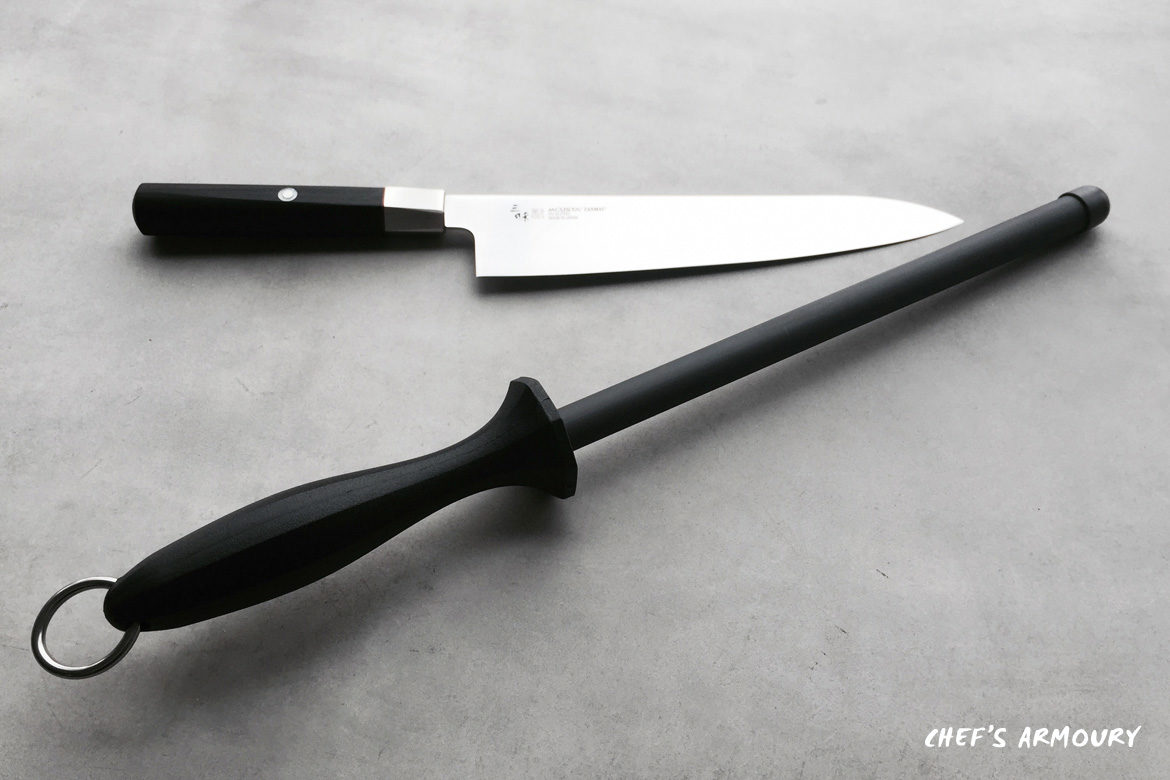Japanese knives should be sharpened on stones right? So where does the steel fit in in the Japanese knife world?
Firstly never, never, never use a sharpening steel of any description on a kataba blade. Deba, usuba and yanagiba which are all kataba, or single beveled knives will be damaged on a steel.
In terms of ryoba blades such as chef knives and utility knives, whether offset or 50/50 bevel, they can all benefit from a tune up on a steel when you don’t have time, or simply can’t be bothered to use a sharpening stone. It also takes less skill than using a waterstone and can be a stop gap measure in between professional sharpening.
While honing steels don’t have the effect of reshaping the bevel to an acute edge, they do remove a small amount of metal and re-align the microscopic burr to a straight line, increasing cutting ability for a while.
There are 3 main types of steels
- Diamond steel
- Stainless steel honing steel
- Ceramic steel
What steels are not recommended?
DIAMOND steels are the worst culprits when it comes to badly honed knives. Given the type of superfast abrasive, they tend to remove a lot of steel from the edge and in a very short time. It’s very difficult to apply even pressure throughout the length of the blade and as a result we see many misshapen blades come in for professional sharpening after honing on diamond steels.
STAINLESS STEEL honing steels range from super smooth to very coarse with the majority being too coarse for Japanese blades. Some of the smoother versions with super fine teeth are good to use but very hard to find and generally expensive.
What type of honing steel is the best – Japan knives
Given the delicate nature of Japanese knives, CERAMIC steels are highly recommended but not all ceramic steels are equal. Look for a ceramic steel that is reinforced internally such as the Chef’s Armoury black ceramic steel, as many others are just a stick of ceramic that can snap easily.
Recommended honing steels – European knives
Ceramic steels are also excellent for European knives.
A fine to medium metal steel can also be used, as long as there are no heavy grooves or ridges in the steel. However we find ceramic cuts a little better for faster results.
How often should I use a honing steel?
If you have a knife with a softer steel like a Global knife, Victorinox, or other European knives, you will find yourself using a steel more often but rule of thumb is if the knife can’t cut a tomato skin cleanly then use the steel. If it still doesn’t cut a tomato cleanly it’s time to use a stone.
With Japanese knives made of harder steel, you will use the steel less often than on European knives, but it’s handy to have a steel in the kitchen when you need a quick fix.
How to care for steels?
Diamond steels lose their effectiveness as they lose grit but those made of ceramic and steel just need a good scrub with a green scourer and hot soapy water to remove left over knife particles.
How do you use a ceramic steel?
See sharpening steel instructions page on our website
…


3 Comments
[…] If you should not be using honing steel to keep your Japanese kitchen knives in tip-top shape, what should you be using as an alternative? […]
Sharpening stones would be the recommended alternative.
[…] frequency with which you hone your knife will largely depend on the steel it is made from, how often you use your knives, and your chosen method of […]